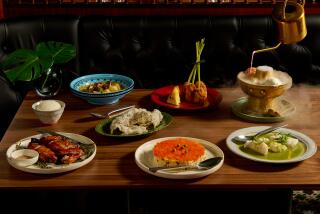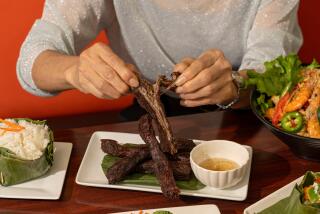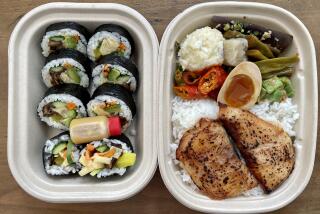Affordable Access to Asia
Kuala Lumpur, Malaysia — As we were eating dinner on the front porch of a restaurant in George Town, Malaysia, we were startled by a sudden “whap!” A gecko had fallen from the ceiling onto our table, narrowly missing my beer. The creature, too mortified even to mumble “Pardon me,” gathered itself and exited between the salt and pepper shakers, leaving me to contemplate how things fall into one’s life.
That’s why we were in Malaysia in the first place. A few weeks earlier a colleague had pointed out a Malaysia Airlines ad promoting its “AccessAsia Pass”: 24 cities in Asia for $747. That included round-trip air fare between LAX and Kuala Lumpur and all the flights you could fit into 30 days. True, each of the cities (other than the carrier’s Kuala Lumpur hub) could be visited only once, but I found no deal killers lurking in the fine print.
Because of the devaluation of local currencies and the post-Sept. 11 fall-off in international travel, Southeast Asia can be a bargain for Americans. Getting here had once seemed prohibitively high, but now we had stumbled on a cheap way to fly and to explore several places besides. I was almost giddy with possibilities.
It was then that my wife, Janice, and I encountered our first challenge: the kid-in-the-candy-store syndrome. We considered Beijing, Tokyo, Shanghai, Manila, but Asia is not a compact neighborhood. Many of the 24 cities were thousands of miles apart. It was like saying, “As long as we’re in Las Vegas, we could swing by Montreal.”
So we focused on places closer to Kuala Lumpur, where we would start, then fly to George Town on the Malaysian island of Penang, a recommendation from our son. Next would be Bangkok, for its magnificent temples, with a side trip to some other, less urban Thai destination. By then we would be more than halfway through our month of travel, so I proposed a stop in Phuket, a Thai resort island where we could recharge.
Finally we would go to Taipei, neither close to the hub nor a romantic travel destination, but not requiring the return to Kuala Lumpur because the plane to LAX has to stop in Taipei.
I called the airline’s toll-free number, prepared to spend an hour on the phone working through various permutations of our desired itinerary. As with frequent-flier deals, some flights have only a certain number of seats allocated for the AccessAsia promotion. To my surprise, only one leg of the trip -- Los Angeles to Kuala Lumpur -- was unavailable on the desired date, and within a few minutes I was able to get my itinerary merely by shifting everything by one day. Our schedule did not quite fit the seasonal “window” (Jan. 15 to May 31 and Aug. 15 to Nov. 15 last year). But $985 for nine flights wasn’t bad.
More things dropped into our lives. First, the “Today” show went to Angkor Wat in Cambodia as part of its “Where in the World Is Matt Lauer?” feature. Janice fell in love with the pictures, but I had to tell her that, although Phnom Penh -- only 200 miles from Angkor Wat -- was one of Air Malaysia’s cities, our itinerary was locked in. A change, if one were possible, would cost us.
But then something else landed in our laps. Because of a lost fax, our reservations had never been finalized. So we started fresh. Four days in Phuket became four days in Cambodia.
Our trip involved elaborate preparations, including immunizations, a visa (for Cambodia) and other necessary details of travel, but the one thing we didn’t do was make hotel reservations. We didn’t want to be tied to a particular city if we discovered that a nearby location might be more fun. We had no trouble finding well-located, modestly priced hotels. They were clean, comfortable and had private, Western-style baths, which suited us -- baby boomers who want some creature comfort -- just fine.
We made an exception to the no-reservation policy for our first night, one of our better moves. After 20-some hours in flight, we arrived in Kuala Lumpur, or KL, as it’s nicknamed. My memories of it are mostly a blur because I had jet lag worthy of the New England Journal of Medicine.
Although our body rhythms were still off, we quickly got into the street food routine, finding wok-fried noodles for breakfast and roti pisang (banana crepes) and star fruit juice for lunch -- or was that dinner?
Our next flight was six days away, but we decided not to spend them all in KL. After visiting the National Museum, seeing the landmark Petronas office towers (at 1,483 feet, ranked among the tallest buildings in the world) and taking each other’s photo with the mounted guards in front of the royal palace, we headed for Malacca, a southwest Malaysian town made famous by the 15th century spice trade.
Malacca was not on the AccessAsia city lineup, but it was only a 2 1/2-hour bus ride from KL on a modern highway. Our cozy bus was clean and comfortable and cost only $2. And like so much on our trip, it was overly air-conditioned. I often wished I had packed a sweater. After even a brief walk outdoors, I’d be sweaty, then I’d get on a bus or enter a cafe so cold I could see my breath. As a result I had the sniffles constantly.
A cultural, culinary fusion
Malacca was an important shipping port for European spice traders but is also interesting for the culture of Baba and Nyonya, the Malaysia-born descendants of Chinese settlers. Some members of these groups prospered during Malacca’s reign as a trading power and built fascinating mansions, now museums, which we visited in Malacca’s Chinatown. Their cuisine fuses Chinese technique and Malaysian ingredients, particularly coconut milk and chilies.
Malacca is a cultural fusion as well. Chinese, Indians, Indonesians and Europeans influenced the development of the city, their touches visible in its layout, architecture and houses of worship. Symbolically, in one part of the city, within a block of one another are a Hindu temple, a Buddhist temple and, of course, a mosque in largely Muslim Malaysia.
To the delight of the 8-year-old boy in me, Malacca has monitor lizards. These more docile cousins of Komodo dragons lounge along the riverbank and occasionally scurry through the drains. Unlike geckos, the beasts do not drop onto one’s dinner table from the ceiling, which is a good thing because they can reach 7 feet long and 130 pounds.
We returned to KL for an overnight before our flight to Penang. We had seen the old Heritage Station Hotel while sightseeing; it is part of the ornate KL train station. (Said one tour guide: “Our train station looks like a mosque, and our mosque looks like a train station.”)
From the outside it seemed old and charming, but on the inside it was old and, well, it’s hard to feel charmed when a light fixture falls off the wall in the middle of the night and hits your wife as she sleeps.
By contrast, the new 100 mph express train to the airport was smooth and efficient. It was a match for the airport, itself only 3 years old. Kuala Lumpur International Airport, or KLIA, which looks as though it were designed by a trendy kitchen remodeler, has lots of glass and natural light, stainless steel and muted colors. We got to know KLIA well because we passed through it five times as the pivot point for our travels.
We pursued Penang’s multiplicity of ethnic cuisines, explored its British colonial history and took trips into the countryside. We visited a snake temple, where I declined an invitation to fondle a tree viper. We sampled the exotic fresh fruits -- hairy red rambutans, exquisite mangosteens and lychee-like things called duku-duku.
We tried the notorious durian, a fruit that, though popular, smells so bad that hotels ban them. (Imagine a combination of rotten onions and old sweat socks.) If you can get past the smell, though, durians taste custardy and indefinably fruity.
Penang was our last stop in Malaysia (excluding connections at KLIA). We spent the next 10 days in Thailand, first taking three days in Bangkok, which is about all one can stand. Bangkok was worth the frustrations -- its un-walkability chief among them -- for its incomparable temples and its Buddhas, big, small, reclining, gold and emerald.
We soon escaped the hubbub of Bangkok for Chiang Mai, the old northern Thai capital. Malaysia Airlines doesn’t go there, but still we flew instead of taking the bus -- saving about 20 hours’ travel time, which we used to dine in Chiang Mai’s restaurants.
Hikers, bikers and trekkers use Chiang Mai as a jumping-off point; some consider it too urbanized. But we enjoyed the city, particularly its perpetual festival of street food.
We also went to a massage school (as customers, not students) for inexpensive, thoroughly relaxing sessions of muscle-stretching rubdowns.
It was just the thing for people who had spent too much time in economy-class seating.
The magic of Angkor Wat
After the relative modernity of Malaysia and Thailand, Phnom Penh was heartbreaking. One can see in its neglected streets and war-ravaged mansions how beautiful it once was. The city’s economy struggles at an almost primitive level; platoons of beggars seem to wait at every corner.
In view of all that, it seems petty to complain that Cambodia has no ATMs. We’ve been spoiled in our travels. But the automatic teller hasn’t made it to Cambodia yet, and we worried that our few dollars (U.S. dollars are virtually official currency in Cambodia) would run out. Fortunately, we found a bank where we got a credit card cash advance, but the fee -- about 15% -- made me wince.
Our goal in Cambodia was Angkor Wat. This time our choice was plane or boat, and again we chose to fly, this time on Siem Reap Airlines in a small, modern turboprop.
Angkor Wat’s centuries-old brick faces smile and sneer and command from the heights; sandstone nagas (reptiles) slither along bridges; entire walls are taken up with detailed bas-relief representations of historic battles, which also display everyday aspects of ancient daily life. Gods and heroes battle; everyday folks cook and flirt and play games.
I worry that tourists will love this place to death. It is too big -- Angkor Thom, just one of several temple sites, covers 3 1/2 square miles alone -- and tourists scramble over temples at will. Nature may destroy some old temples whose walls are ensnared in the roots of giant trees.
We feel lucky to have seen it. Thank you, Matt Lauer, and thank you, clerical glitch that lost our first fax.
We thought our luck had run out on the trip back, this one on Royal Phnom Penh Airways. As the old plane’s engines cranked up, shaking everything, vapor poured out of the ventilation system. Janice grabbed my hand and blurted, “I love you.”
Spending time in Taiwan
On the way to Taiwan, I thought about those four days of relaxing in Phuket that we had given up. Having been on the road for more than three weeks, I was starting to feel tired, frazzled and weary of living out of a roll-on bag. And Malaysia Airlines seemed always to have only two meals: sweet and sour fish, and chicken curry with noodles. On days when your stomach is on the edge of motion sickness, you don’t want to think about either of them.
But Taipei was better than I expected. Though it’s often portrayed as unfriendly, polluted and dull, we found it was none of those.
Locals sought us out to practice their English and volunteered to help us plan our sightseeing. Although the streets were crowded, particularly with motorbikes, pollution was mild compared with some European and Middle Eastern cities.
We found interesting things to do. The National Palace Museum holds ancient artifacts and treasures from the Chinese mainland; the old markets sell items as diverse as snake meat and motorbike parts.
The huge memorials to Chinese visionary Sun Yat-sen and legendary leader Chiang Kai-shek provide interesting (if subjective) historical views of Taiwan’s relation to mainland China. The city subway system, with signs and voice announcements in Mandarin and English, is easy to navigate.
Then it was back to the airport for the last time. Once more through security, where, as at the other Asian airports, scrutiny was less intense than in the U.S. During the flight across the Pacific, I had lots of time to think: to picture the stacks of bills accumulating at the post office; to worry about whether our lawn had died; to consider how lucky we were to have taken this trip.
And to think about how meals at home just wouldn’t be the same without the occasional falling gecko.
More to Read
Sign up for The Wild
We’ll help you find the best places to hike, bike and run, as well as the perfect silent spots for meditation and yoga.
You may occasionally receive promotional content from the Los Angeles Times.






